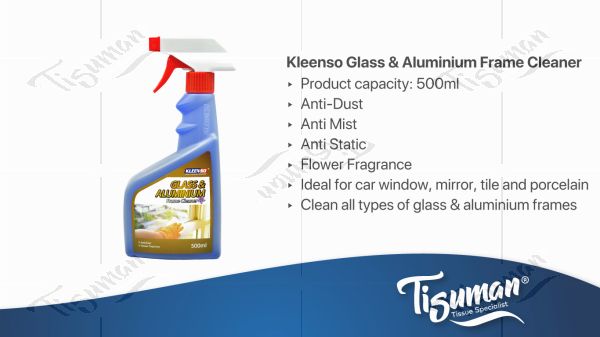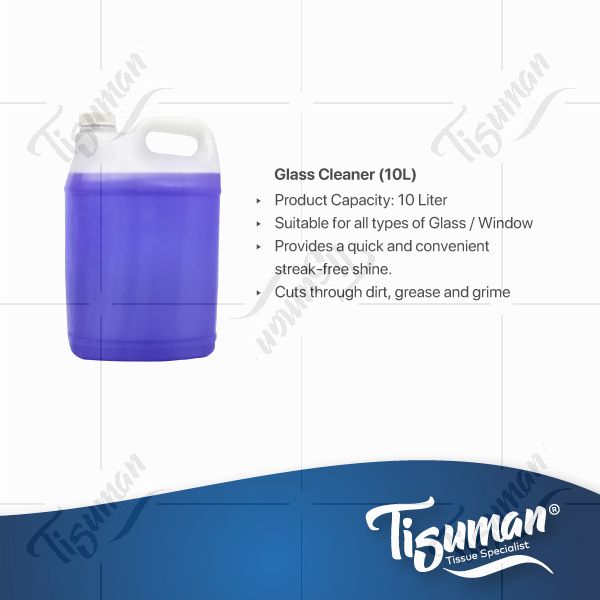Glass is a versatile material commonly used in homes, offices, and various other settings. Its transparent and reflective properties make it ideal for windows, mirrors, tabletops, and a wide range of decorative applications. However, keeping glass surfaces clean and sparkling can be a challenging task. Fortunately, a wide variety of Glass Cleaners are available to help you achieve effortlessly clean and streak-free results.
Understanding the Basics of Glass Cleaners

Glass cleaners are typically formulated with a combination of surfactants, solvents, and other ingredients designed to dissolve and remove dirt, grime, and fingerprints from glass surfaces. The effectiveness of a glass cleaner primarily depends on its ability to:
- Cut through grease and grime: Surfactants are the primary cleaning agents in glass cleaners. They help break down and dissolve grease, oil, and other contaminants on the glass surface.
- Remove dirt and dust: Solvents, such as alcohol or ammonia, help dissolve and lift dirt and dust particles away from the glass, leaving it sparkling clean.
- Prevent streaking: Additives, such as isopropanol or butyl cellosolve, help prevent streaking by allowing the cleaner to dry quickly and evenly.
There are different types of glass cleaners available in the market, each with their own unique formulations and intended applications. Let’s take a closer look at some of the most common types of glass cleaners.
Kleenso Anti-Dust Glass: The Revolutionary Solution for Dust-Free Glass

Dust is one of the biggest challenges when it comes to keeping glass surfaces clean. Traditional glass cleaners may remove dirt and grime, but they often leave behind annoying streaks and residue. This is where Kleenso Anti-Dust Glass comes in.
Kleenso Anti-Dust Glass is a revolutionary glass cleaner that not only removes dirt and grime but also leaves behind a protective layer that repels dust. This means you can say goodbye to constantly wiping down your glass surfaces, as they will stay cleaner for longer.
How it Works
Kleenso Anti-Dust Glass is formulated with a unique blend of surfactants, solvents, and Nano particles. These Nano particles create an invisible barrier on the glass surface, making it difficult for dust particles to adhere to it.
This glass cleaner is perfect for high-traffic areas or spaces that are prone to dust, such as living rooms, offices, and commercial spaces. It not only saves you time and effort but also keeps your glass surfaces looking spotless for longer periods.
Benefits of Kleenso Anti-Dust Glass
- Repels dust and keeps glass surfaces cleaner for longer
- Easy and effortless cleaning
- Leaves behind a streak-free and sparkling finish
- Suitable for all types of glass surfaces
- Saves time and effort in regular cleaning
Glass Cleaner – Liquid: The Crystal-Clear Choice for Sparkling Windows
When it comes to cleaning windows, a streak-free finish is crucial for a crystal-clear view. Glass cleaner liquids are specially formulated for windows and other large glass surfaces. They are easy to use and provide excellent results, making them a popular choice among homeowners and professional cleaners alike.
Glass cleaner liquids typically contain a higher concentration of solvents, which help dissolve dirt and grime more effectively. They can be used directly on the glass surface or diluted with water for larger areas.
Tips for Using Glass Cleaner Liquids
- Start by removing any loose dirt or debris from the window using a dry cloth or duster.
- Spray the glass cleaner liquid directly onto the surface or onto a clean cloth.
- Wipe the glass surface in a circular motion, starting from the top and working your way down.
- Use a squeegee to remove excess cleaner and water from the surface.
- If there are any stubborn spots or streaks, repeat the process until the surface is completely clean and streak-free.
Recommended Glass Cleaner Liquids
- Windex Original Glass Cleaner
- Mrs. Meyer’s Clean Day Glass Cleaner
- Seventh Generation Glass Surface Cleaner
The Essential Guide to Glass Cleaning: Techniques and Products
Whether you are cleaning windows, mirrors, or glass tabletops, there are certain techniques and products that can help you achieve the best results. Here are some essential tips for glass cleaning:
Choose the Right Tools
Having the right tools is crucial for effective glass cleaning. Microfiber cloths are ideal for gently removing dirt and grime from glass surfaces without leaving behind any lint or residue. Squeegees are also great for larger surfaces, as they help remove excess cleaner and water for a streak-free finish.
Avoid Direct Sunlight
Cleaning glass surfaces in direct sunlight can lead to streaking, as the heat causes the cleaner to dry too quickly. It is best to clean your windows and other glass surfaces on a cloudy day, or when the sun is not directly shining on them.
Use Proper Techniques
When cleaning windows or large glass surfaces, it is best to work from top to bottom and use horizontal strokes. For smaller surfaces, such as mirrors or tabletops, use vertical strokes starting from the top and working your way down. This helps prevent streaking and ensures an even application of the cleaner.
DIY Glass Cleaner Recipes: Natural and Effective Solutions
If you prefer using natural and non-toxic products, you can easily make your own glass cleaner at home. Here are two simple and effective DIY glass cleaner recipes:
Recipe 1: Vinegar and Water
Mix equal parts of white vinegar and distilled water in a spray bottle. Spray onto the glass surface and wipe clean with a microfiber cloth or newspaper for a streak-free finish. You can also add a few drops of essential oil for a pleasant scent.
Recipe 2: Rubbing Alcohol and Water
Mix one part rubbing alcohol with three parts water in a spray bottle. Spray onto the glass surface and wipe clean with a microfiber cloth or newspaper. This mixture is particularly effective for removing stubborn dirt and grime.
Glass Cleaner Safety: Precautions and Proper Usage
While glass cleaners are generally safe to use, they do contain chemicals that may cause irritation or harm if not used properly. Here are some safety precautions to keep in mind while using glass cleaners:
- Always read and follow the instructions on the label carefully.
- Wear gloves and avoid contact with skin and eyes.
- Use in a well-ventilated area to avoid inhaling fumes.
- Keep out of reach of children and pets.
- Avoid mixing different types of glass cleaners, as this can create harmful fumes.
Streak-Free Glass Cleaning Techniques: Achieving a Spotless Finish
Streaks are a common problem when it comes to glass cleaning. They can be caused by various factors, such as improper techniques, using too much cleaner, or not wiping off excess cleaner and water. Here are some tips to help you achieve a streak-free finish:
- Use a lint-free microfiber cloth or newspaper instead of paper towels, which can leave behind lint.
- Avoid using too much cleaner, as this can lead to streaking.
- Wipe off excess cleaner and water with a squeegee or clean cloth.
- Make sure to dry the edges and corners of the glass surface thoroughly.
- If there are any streaks, buff the surface with a dry microfiber cloth or newspaper.
Glass Cleaner Reviews: Exploring Top Brands and Products
With so many glass cleaners available in the market, it can be challenging to choose the right one for your needs. To help you make an informed decision, here are some top glass cleaner brands and their popular products:
- Windex
- Original Glass Cleaner
- Vinegar Multi-Surface Cleaner
- Ammonia-Free Glass Cleaner
- Method
- Natural Glass + Surface Cleaner
- Mint Glass + Surface Cleaner
- Mrs. Meyer’s Clean Day
- Glass Cleaner
- Lemon Verbena Glass Cleaner
Remember to always read reviews and check product labels before purchasing a glass cleaner to ensure it meets your specific cleaning needs.
Using Glass Cleaner for Mirrors and Other Surfaces: Tips and Tricks
Glass cleaners are not just limited to windows and mirrors; they can also be used to clean other surfaces such as countertops, tabletops, and even stainless steel appliances. Here are some useful tips and tricks for using glass cleaner on different surfaces:
- Mirrors: When cleaning mirrors, use vertical strokes starting from the top and working your way down. This will help prevent streaking.
- Countertops: To remove tough stains or grime from countertops, spray with glass cleaner and let it sit for a few minutes before wiping clean.
- Tabletops: For glass tabletops, use horizontal strokes when cleaning to avoid streaks.
- Stainless Steel Appliances: Spray glass cleaner onto a microfiber cloth and wipe down stainless steel appliances for a shiny and streak-free finish.
The Environmental Impact of Glass Cleaners: Sustainable Practices
While glass cleaners are safe and effective for cleaning glass surfaces, some may contain chemicals that can harm the environment. To minimize your impact and make more sustainable choices, here are some things to keep in mind:
- Look for eco-friendly and non-toxic glass cleaner options.
- Choose products with minimal packaging or packaging made from recycled materials.
- Avoid using excessive amounts of cleaner to reduce waste.
- Consider making your own glass cleaner using natural ingredients.
Conclusion
Glass cleaners are an essential tool for keeping our glass surfaces clean and sparkling. With a wide range of options available, it is important to choose the right type of cleaner and use proper techniques for the best results. Whether you prefer natural DIY solutions or store-bought products, with the tips and information provided in this guide, you can achieve pristine and streak-free glass surfaces in no time. Remember to always prioritize safety and be conscious of your environmental impact when using glass cleaners. Happy cleaning!